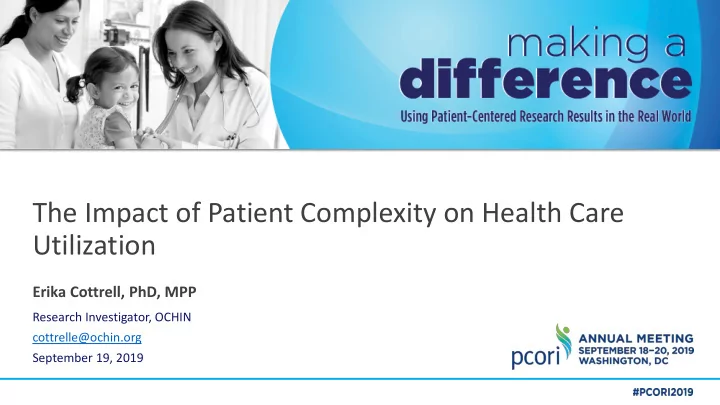

The Impact of Patient Complexity on Health Care Utilization Erika Cottrell, PhD, MPP Research Investigator, OCHIN cottrelle@ochin.org September 19, 2019
Erika Cottrell • Has nothing to disclose 2
Acknowledgement and Research Partners Research reported in this work was funded through a Patient-Centered Outcomes Research Institute (PCORI) Award (HSD-1603-34987). The statements in this presentation are solely the responsibility of the authors and do not necessarily represent the views of the Patient-Centered Outcomes Research Institute (PCORI), its Board of Governors or Methodology Committee. 3
A driving force for health equity 4
OCHIN’s National Impact 500+ Organizations in 47 states | 10K+ Providers The Population We Serve 5.2M Patients in the ADVANCE Research Database 39% Racially Diverse | 35% Hispanic 32% Best Served in a Language Other than English 52% Below Federal Poverty Level Chronic Conditions 55% At least one chronic condition 30% At least one MH/BH diagnosis 5
Why study patient complexity? • Primary care clinics are increasingly evaluated on health outcomes • Many risk adjustment models account for clinical complexity • Despite research demonstrating the impact of social factors, risk adjustment models typically do not account for social complexity 6
Health Systems Demonstration Project Phase I: • Engaged stakeholders to identify high priority research questions 7
Health Systems Demonstration Project Phase I: • Engaged stakeholders to identify high priority research questions 8
Health Systems Demonstration Project Phase I: • Engaged stakeholders to identify high priority research questions Phase II: • Engaged stakeholders to prioritize measures • Partnered with OneFlorida to conduct preliminary analysis in a safety net population 9
Health Systems Demonstration Project Phase I: • Engaged stakeholders to identify high priority research questions Phase II: • Engaged stakeholders to prioritize measures • Partnered with OneFlorida to conduct preliminary analysis in a safety net population Phase III: • Partnered with KPNW validate and extend analysis 10
Phase III: Collaboration with Kaiser Permanente Northwest Patient Insurance Mix 11
Do social factors explain variation in clinical quality outcomes above and beyond clinical complexity? Clinical Social Quality of Care Complexity Complexity Outcome Measures 12
Do social factors explain variation in clinical quality outcomes above and beyond clinical complexity? Clinical Social Quality of Care Complexity Complexity Outcome Measures Charlson Comorbidity Index Diabetes control (HbA1c>9%) Social Deprivation Index Patient-level Patient-level Community-level 13
Odds of Poor Diabetes Control: HbA1c > 9% Model OCHIN KPNW OR (95% CI) OR (95% CI) For KPNW patients, increasing Ref Ref Charlson Score: 0-1 clinical complexity is 1.25 (1.15, 1.37) 1.15 (1.04, 1.27) Charlson Score: 2-3 associated with poorer 1.40 (1.28, 1.53) 1.04 (0.93, 1.17) Charlson Score: 4-5 diabetes control. This trend is not present in the OCHIN 1.64 (1.50, 1.79) 1.07 (0.95, 1.19) Charlson Score: >=6 sample. Social Deprivation Index 1.03 (1.02, 1.04) 1.05 (1.04, 1.07) (Increase of 10) Statistically significant All models adjusted for age and sex OR = Odds Ratio CI = Confidence Interval 14
Odds of Poor Glucose Control: HbA1c > 9% Model OCHIN KPNW OR (95% CI) OR (95% CI) For KPNW patients, increasing Ref Ref Charlson Score: 0-1 clinical complexity is 1.25 (1.15, 1.37) 1.15 (1.04, 1.27) Charlson Score: 2-3 associated with poorer 1.40 (1.28, 1.53) 1.04 (0.93, 1.17) Charlson Score: 4-5 diabetes control. This trend is not present in the OCHIN 1.64 (1.50, 1.79) 1.07 (0.95, 1.19) Charlson Score: >=6 sample. Social Deprivation Index 1.03 (1.02, 1.04) 1.05 (1.04, 1.07) (Increase of 10) Statistically significant Increasing social complexity in the patients’ census tract is associated with All models adjusted for age and sex poorer diabetes control in both samples. OR = Odds Ratio CI = Confidence Interval 15
“Cold Spot” Communities (Highest Social Deprivation) Those living in “cold spots” had 24% and 12% higher odds of poor diabetes control in the OCHIN and KPNW samples, respectively 16
Stakeholder Engagement: Cross-cutting Themes from Patients, Health Systems Leaders, and Clinicians • Safety net clinics have very high levels of social deprivation relative to the U.S. population • Providers from these clinics may benefit from having their performance metrics adjusted to account for the social complexity of their patients 17
Potential Clinical and Policy Implications • Community-level data can help us understand the social complexity of different populations • Findings highlight the need to consider social factors in the developing performance metrics and how we pay providers • Risk-adjustment models incorporating social complexity would especially benefit providers serving more socially-complex groups 18
Thank You! Erika Cottrell Research Investigator, OCHIN cottrelle@ochin.org 19
Recommend
More recommend